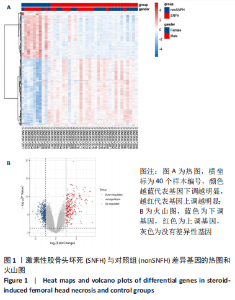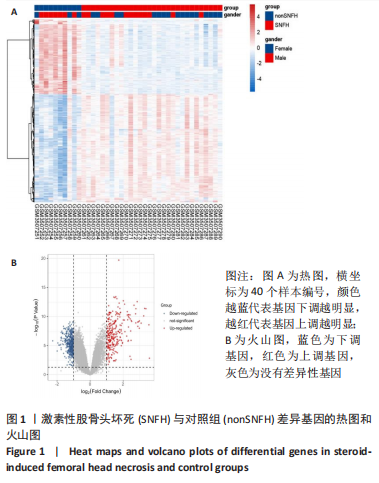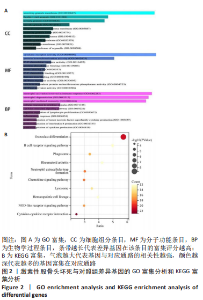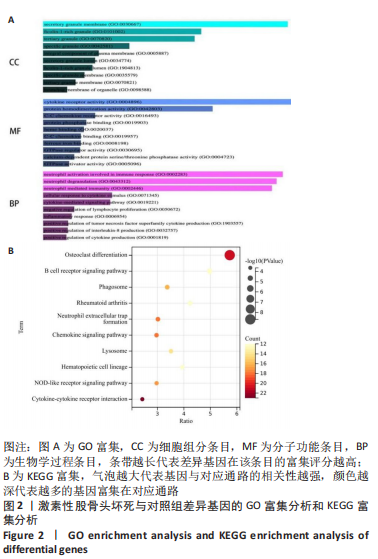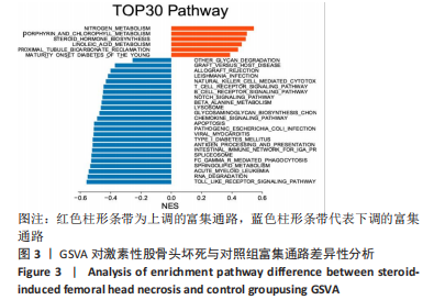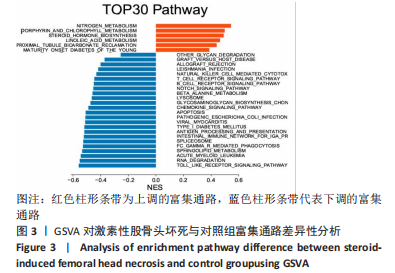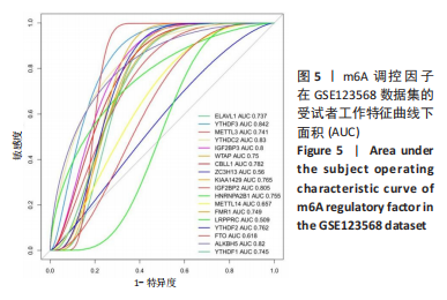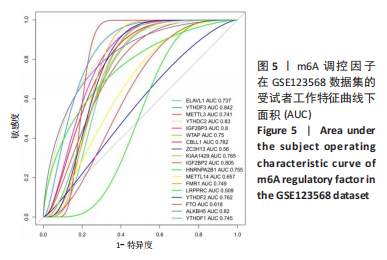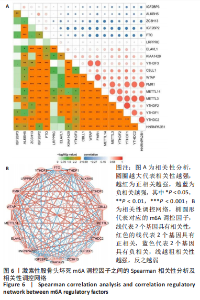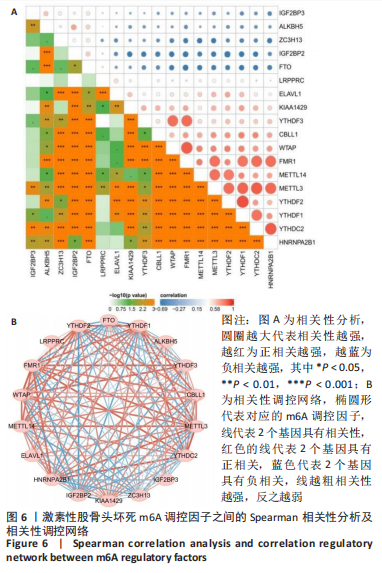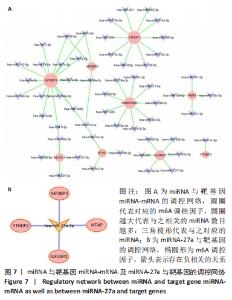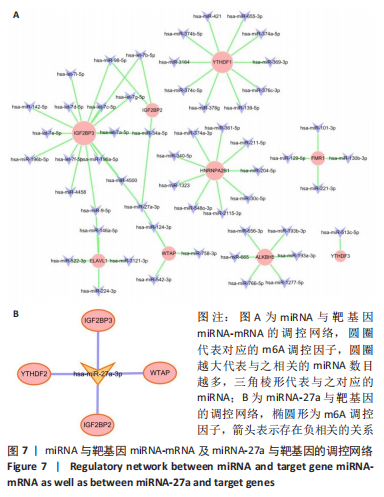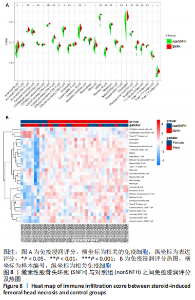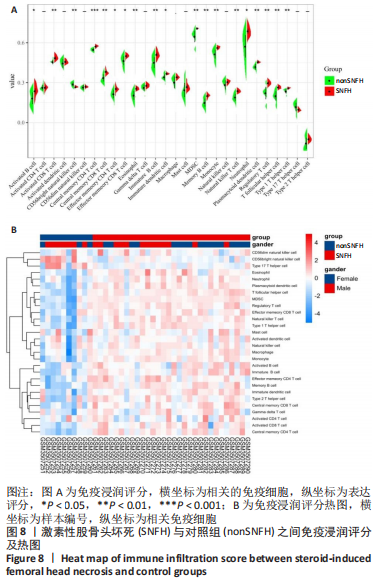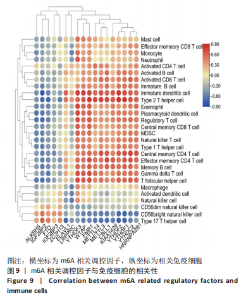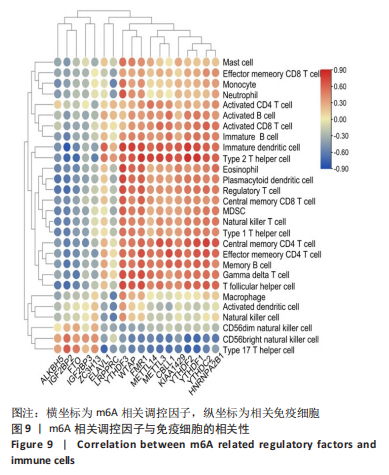Chinese Journal of Tissue Engineering Research ›› 2024, Vol. 28 ›› Issue (14): 2159-2165.doi: 10.12307/2024.329
Previous Articles Next Articles
Identification of differences in N6-methyladenosine-related genes in steroid-induced femoral head necrosis
Yuan Tianyi1, Liu Hongjiang1, Yang Zengqiang1, Lu Xingbao1, Maimaitiyibubaji1, Zhou Zhiheng1, Cui Yong1, 2
- 1The Fifth Clinical Medical College of Xinjiang Medical University, Urumqi 830011, Xinjiang Uygur Autonomous Region, China; 2Department of Orthopedics, the Fifth Affiliated Hospital of Xinjiang Medical University, Urumqi 830011, Xinjiang Uygur Autonomous Region, China
-
Received:2023-04-12Accepted:2023-05-25Online:2024-05-18Published:2023-07-28 -
Contact:Cui Yong, Chief physician, Associate professor, Master’s supervisor, The Fifth Clinical Medical College of Xinjiang Medical University, Urumqi 830011, Xinjiang Uygur Autonomous Region, China; Department of Orthopedics, the Fifth Affiliated Hospital of Xinjiang Medical University, Urumqi 830011, Xinjiang Uygur Autonomous Region, China -
About author:Yuan Tianyi, Master candidate, The Fifth Clinical Medical College of Xinjiang Medical University, Urumqi 830011, Xinjiang Uygur Autonomous Region, China -
Supported by:National Natural Science Foundation of China, No. 81960396 (to CY)
CLC Number:
Cite this article
Yuan Tianyi, Liu Hongjiang, Yang Zengqiang, Lu Xingbao, Maimaitiyibubaji, Zhou Zhiheng, Cui Yong. Identification of differences in N6-methyladenosine-related genes in steroid-induced femoral head necrosis[J]. Chinese Journal of Tissue Engineering Research, 2024, 28(14): 2159-2165.
share this article
Add to citation manager EndNote|Reference Manager|ProCite|BibTeX|RefWorks
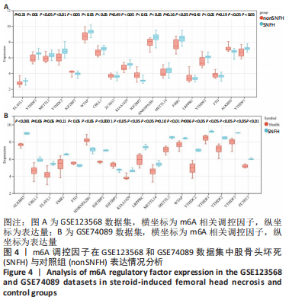
2.3 m6A相关调控因子在GSE123568数据集和GSE74089数据集中差异表达分析结果 将m6A调控因子在GSE123568数据集中激素股骨头坏死和非激素股骨头坏死表达分析发现,其中METTL3、IGF2BP3、WTAP、CBLL1、KIA1429、HNRNPA2B1、FMR1、YTHDF2、ALKBH5、YTHDF1表达差异(P < 0.05),YTHDF3、YTHDC2、IGF2BP2表达差异(P < 0.01);IGF2BP3、IGF2BP2、ALKBH5在激素股骨头坏死组中为下调性表达,YTHDF3、YTHDC2、METTL3、WTAP、CBLL1、KIA1429、HNRNPA2B1、FMR1、YTHDF2、YTHDF1在激素股骨头坏死组中为上调性表达,见图4A。m6A调控因子在GSE74089数据集股骨头坏死组与对照组软骨组织中表达分析发现,YTHDF2在股骨头坏死组中为高表达,并且差异有显著性意义(P < 0.05),图4B。将m6A调控因子在GSE123568数据集进行受试者工作特征曲线分析发现,其中YTHDF3、YTHDC2、IGF2BP3、CBLL1、KIA1429、IGF2BP2、HNRNPA2B1、YTHDF2中的受试者工作特征AUC均> 0.75,因此认为其可以作为激素性股骨头坏死的生物标志物,见图5。"
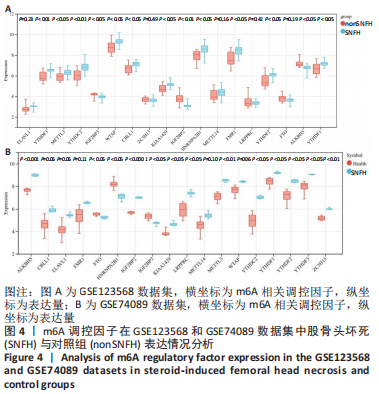
| [1] LV W, YU M, YANG Q, et al.Total flavonoids of Rhizoma drynariae ameliorate steroid‑induced avascular necrosis of the femoral head via the PI3K/AKT pathway. Mol Med Rep. 2021;23(5):345. [2] CHANG C, GREENSPAN A, GERSHWIN ME. The pathogenesis, diagnosis and clinical manifestations of steroid-induced osteonecrosis. J Autoimmun. 2020;110:102460. [3] SUN F, ZHOU JL, WEI SX, et al. Glucocorticoids induce osteonecrosis of the femoral head in rats via PI3K/AKT/FOXO1 signaling pathway. PeerJ. 2022;10: e13319. [4] LIN T, CHEN W, YANG P, et al. Bioinformatics analysis and identification of genes and molecular pathways in steroid-induced osteonecrosis of the femoral head. J Orthop Surg Res. 2021;16(1):327. [5] HAN N, QIAN F, NIU X, et al. Circ_0058792 regulates osteogenic differentiation through miR-181a-5p/Smad7 axis in steroid-induced osteonecrosis of the femoral head. Bioengineered. 2022;13(5):12807-12822. [6] ZHANG X, YOU JM, DONG XJ, et al.Administration of mircoRNA-135b-reinforced exosomes derived from MSCs ameliorates glucocorticoid-induced osteonecrosis of femoral head (ONFH) in rats. J Cell Mol Med. 2020;24(23): 13973-13983. [7] LIANG JQ, ZHOU Z AO, BO L, et al. Phosphoglycerate kinase 1 silencing by a novel microRNA microRNA-4523 protects human osteoblasts from dexamethasone through activation of Nrf2 signaling cascade. Cell Death Dis. 2021;12(11):964. [8] WANG Q, YANG Q, CHEN G, et al. LncRNA expression profiling of BMSCs in osteonecrosis of the femoral head associated with increased adipogenic and decreased osteogenic differentiation. Sci Rep. 2018;8(1):9127. [9] XU Z, LV B, QIN Y, et al. Emerging Roles and Mechanism of m6A Methylation in Cardiometabolic Diseases. Cells. 2022;11(7):1101. [10] HE PC, HE C. m6 A RNA methylation: from mechanisms to therapeutic potential. EMBO J. 2021;40(3):e105977. [11] MURAKAMI S, JAFFREY SR. Hidden codes in mRNA: Control of gene expression by m(6)A. Mol Cell. 2022;82(12):2236-2251. [12] Ye L, Fan Z, Yu B, et al. Histone Demethylases KDM4B and KDM6B Promote Osteogenic Differentiation of Human MSCs. Cell Stem Cell. 2018;23(6):898-899. [13] CHENG C, ZHANG H, ZHENG J, et al. METTL14 benefits the mesenchymal stem cells in patients with steroid-associated osteonecrosis of the femoral head by regulating the m6A level of PTPN6. Aging (Albany NY). 2021;13(24): 25903-25919. [14] PAROLA C, NEUMEIER D, REDDY ST. Integrating high-throughput screening and sequencing for monoclonal antibody discovery and engineering.Immunology. 2018;153(1):31-41. [15] RITCHIE M E, PHIPSON B, WU D, et al. limma powers differential expression analyses for RNA-sequencing and microarray studies. Nucleic Acids Res. 2015;43(7):e47. [16] ZHOU L Q, SHEN J X, ZHOU J Y, et al. The prognostic value of m6A-related LncRNAs in patients with HNSCC: bioinformatics analysis of TCGA database.Sci Rep. 2022;12(1):579. [17] TANG C, KLUKOVICH R, PENG H, et al. ALKBH5-dependent m6A demethylation controls splicing and stability of long 3’-UTR mRNAs in male germ cells. Proc Natl Acad Sci U S A. 2018;115(2):E325-E333. [18] KULESHOV MV, JONES MR, ROUILLARD AD, et al. Enrichr: a comprehensive gene set enrichment analysis web server 2016 update. Nucleic Acids Res. 2016;44(W1):W90-W97. [19] WANG S, MATSUMOTO K, LISH SR, et al. Budding epithelial morphogenesis driven by cell-matrix versus cell-cell adhesion. Cell. 2021;184(14):3702-3716. [20] CHAI Q, YU S, ZHONG Y, et al. A bacterial phospholipid phosphatase inhibits host pyroptosis by hijacking ubiquitin. Science. 2022;378(6616):eabq0132. [21] TAKEDA K, AKIRA S. TLR signaling pathways. Semin Immunol. 2004;16(1):3-9. [22] ZHANG S, WANG C, SHI L, et al. Beware of Steroid-Induced Avascular Necrosis of the Femoral Head in the Treatment of COVID-19-Experience and Lessons from the SARS Epidemic. Drug Des Devel Ther. 2021;15:983-995. [23] NAN K, ZHANG Y, ZHANG X, et al. Exosomes from miRNA-378-modified adipose-derived stem cells prevent glucocorticoid-induced osteonecrosis of the femoral head by enhancing angiogenesis and osteogenesis via targeting miR-378 negatively regulated suppressor of fused (Sufu). Stem Cell Res Ther. 2021;12(1):331. [24] 王毅.成人股骨头缺血性坏死患者临床症状、CT与MRI影像学表现特点分析[J].中国CT和MRI杂志,2021,19(9):176-179. [25] WANG B, GONG S, SHAO W, et al. Comprehensive analysis of pivotal biomarkers, immune cell infiltration and therapeutic drugs for steroid-induced osteonecrosis of the femoral head. Bioengineered. 2021;12(1):5971-5984. [26] SALIMINEJAD K, KHORRAM KHORSHID HR, SOLEYMANI FARD S, et al. An overview of microRNAs: Biology, functions, therapeutics, and analysis methods. J Cell Physiol. 2019;234(5):5451-5465. [27] Liu GZ, Chen C, Kong N, et al. Identification of potential miRNA biomarkers for traumatic osteonecrosis of femoral head. J Cell Physiol. 2020; 235(11):8129-8140. [28] XU P, CHANG J, MA G, et al. MiR-145 inhibits the differentiation and proliferation of bone marrow stromal mesenchymal stem cells by GABARAPL1 in steroid-induced femoral head necrosis. BMC Musculoskelet Disord. 2022;23(1):1020. [29] LIN L, YU Y, LIU K, et al. Downregulation of miR-30b-5p Facilitates Chondrocyte Hypertrophy and Apoptosis via Targeting Runx2 in Steroid-Induced Osteonecrosis of the Femoral Head. Int J Mol Sci. 2022;23(19):11275. [30] ZHANG L, HOU C, CHEN C, et al. The role of N(6)-methyladenosine (m(6)A) modification in the regulation of circRNAs. Mol Cancer. 2020;19(1):105. [31] DAS MANDAL S, RAY PS. Transcriptome-wide analysis reveals spatial correlation between N6-methyladenosine and binding sites of microRNAs and RNA-binding proteins. Genomics. 2021;113(1 Pt 1):205-216. [32] LI L, XU N, LIU J, et al. m6A Methylation in Cardiovascular Diseases: From Mechanisms to Therapeutic Potential. Front Genet. 2022;13:908976. [33] BAI Q, SHI M, SUN X, et al. Comprehensive analysis of the m6A-related molecular patterns and diagnostic biomarkers in osteoporosis. Front Endocrinol (Lausanne). 2022;13:957742. [34] FANG R, CHEN X, ZHANG S, et al. EGFR/SRC/ERK-stabilized YTHDF2 promotes cholesterol dysregulation and invasive growth of glioblastoma. Nat Commun. 2021;12(1):177. [35] 黄涛, 崔泳. miRNA-27α调控PPARγ/ApoA5通路对大鼠激素性股骨坏死的影响研究[J].实用骨科杂志,2021,27(4):330-334. [36] Park-Min KH. Metabolic reprogramming in osteoclasts. Semin Immunopathol. 2019;41(5):565-572. [37] TAUBMANN J, KRISHNACOUMAR B, BÖHM C, et al.Metabolic reprogramming of osteoclasts represents a therapeutic target during the treatment of osteoporosis. Sci Rep. 2020;10(1):21020. [38] CHEN K, LIU Y, HE J, et al. Steroid-induced osteonecrosis of the femoral head reveals enhanced reactive oxygen species and hyperactive osteoclasts.Int J Biol Sci. 2020;16(11):1888-1900. [39] 梁学振,骆帝,李嘉程,等.激素性股骨头坏死中的PTGS2和STAT3:潜在铁死亡相关诊断生物标志物[J].中国组织工程研究,2023,27(36): 5898-5904. |
| [1] | Shan Jiaxin, Zhang Yilong, Wu Hongtao, Zhang Jiayuan, Li Anan, Liu Wengang, Xu Xuemeng, Zhao Chuanxi. Changes in muscle strength and pain in patients receiving Jianpi Yiqi Huoxue Formula after total knee arthroplasty [J]. Chinese Journal of Tissue Engineering Research, 2024, 28(9): 1378-1382. |
| [2] | Shen Jiangyong, He Xi, Tang Yuting, Wang Jianjun, Liu Jinyi, Chen Yuanyuan, Wang Xinyi, Liu Tong, Sun Haoyuan. RAS-selective lethal small molecule 3 inhibits the fibrosis of pathological scar fibroblasts [J]. Chinese Journal of Tissue Engineering Research, 2024, 28(8): 1168-1173. |
| [3] | Tan Nengxian, Wu Wenzheng, Zheng Churong, Luo Lieliang, Gu Peng, Ouyang Chongzhi, Zheng Xiaohui. Finite element analysis of different fixation methods of partially threaded cannulated screws for treating vertical femoral neck fractures [J]. Chinese Journal of Tissue Engineering Research, 2024, 28(6): 873-878. |
| [4] | Zheng Jiafa, Song Xiufeng, Li Hongzhi, Zhou Jinming, Guan Shengyi, Yu He. Open reduction and internal fixation via the para-Achilles tendon approach for the treatment of posterior malleolus sandwich fractures [J]. Chinese Journal of Tissue Engineering Research, 2024, 28(6): 934-938. |
| [5] | Zhou Xiaowen, Fu Zuchang, Huang Fei, Ai Jianguo, Zhao Feng. Bone defect blocked by bone cement segmental filling in single-plane tibial bone transport [J]. Chinese Journal of Tissue Engineering Research, 2024, 28(5): 736-740. |
| [6] | Wu Tian, Zhao Yue, Hu Rong. Effect of nanobubbles carrying double antibodies on the proliferation of ovarian cancer cells [J]. Chinese Journal of Tissue Engineering Research, 2024, 28(3): 341-346. |
| [7] | Gao Xueyu, Zhang Wentao, Sun Tianze, Zhang Jing, Li Zhonghai. Application of metal ions in bone tissue engineering [J]. Chinese Journal of Tissue Engineering Research, 2024, 28(3): 439-444. |
| [8] | Han Biao, Li Ji, Li Bin, Sun Bo, Zong Shuangle, Wang Hongrun, Li Dongmei, Li Ligeng, Wang Bin. Finite element analysis of optimal fixation method for femoral neck fracture with different reduction conditions [J]. Chinese Journal of Tissue Engineering Research, 2024, 28(12): 1810-1814. |
| [9] | Zeng Jiaxu, He Qi, Chen Bohao, Li Miao, Li Shaocong, Yang Junzheng, Pan Zhaofeng, Wang Haibin. An insight into the mechanism of iron overload in knee osteoarthritis under the theory of blood stasis [J]. Chinese Journal of Tissue Engineering Research, 2024, 28(11): 1743-1748. |
| [10] | Zhang Li, Yang Wenjun, Sang Xiaohong, Han Yuanyuan, Mao Zhijie, Wang Shun, Lu Chen. Effect of overexpression of protein phosphatase 2Cm on transcriptome of human renal tubular epithelial cells [J]. Chinese Journal of Tissue Engineering Research, 2024, 28(1): 68-73. |
| [11] | Guo Shuhui, Yang Ye, Jiang Yangyang, Xu Jianwen. Screening and validation of neurogenic bladder miRNA-mRNA regulatory network [J]. Chinese Journal of Tissue Engineering Research, 2023, 27(在线): 1-8. |
| [12] | Li Wenjie, You Aijia, Zhou Junli, Fang Sujuan, Li Chun. Effects of different dressings in the treatment of burn wounds: a network meta-analysis [J]. Chinese Journal of Tissue Engineering Research, 2023, 27(7): 1141-1148. |
| [13] | Yang Heng, Zheng Liying, Liu Zhili, Wang Qinzhang, Hao Zhiqiang, Wang Jingshen, Wang Yuan, Li Yongle, Tan Minghui, Zou Xiaofeng, Zhang Guoxi, Huang Ruohui, Jiang Bo, Qian Biao. Physiological function of the testis in rats undergoing different parts of vasectomy [J]. Chinese Journal of Tissue Engineering Research, 2023, 27(5): 720-725. |
| [14] | Ma Shengnan, Ke Jingyue, Dong Hongming, Shen Shuang, Ding Hao, Li Jianping, Li Guqiang. Balance and gait characteristics of static standing and walking after anterior cruciate ligament reconstruction [J]. Chinese Journal of Tissue Engineering Research, 2023, 27(36): 5784-5789. |
| [15] | Qi Xue, Li Jiahui, Zhu Yuanfeng, Yu Lu, Wang Peng. Phosphorylation modification of alpha synuclein in serum of patients with Parkinson’s disease [J]. Chinese Journal of Tissue Engineering Research, 2023, 27(35): 5577-5582. |
| Viewed | ||||||
|
Full text |
|
|||||
|
Abstract |
|
|||||
